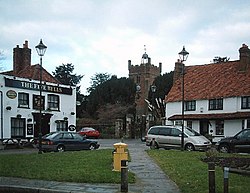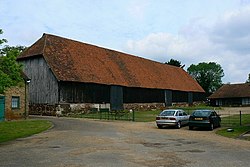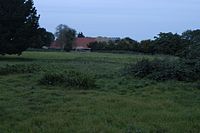Harmondsworth
| Harmondsworth | |
| Middlesex | |
|---|---|
 Harmondsworth Village | |
| Location | |
| Grid reference: | TQ055775 |
| Location: | 51°29’11"N, 0°28’47"W |
| Data | |
| Population: | 1,478 (2011) |
| Post town: | West Drayton |
| Postcode: | UB7 |
| Dialling code: | 020 |
| Local Government | |
| Council: | Hillingdon |
| Parliamentary constituency: |
Hayes and Harlington |
Harmondsworth is a village in the south-west of Middlesex, uncomfortably close to Heathrow Airport, immediately to the south. The village adjoins the M4 motorway and the Bath Road (the A4).
The name of the village comes from the Old English Heremodes weorþ or Heremundes weorþ, meaning "Heremod's (or Heremund's) enclosure".
Harmondsworth is an ancient parish which once included the large hamlets of Heath Row, Longford and Sipson. Longford and Sipson have modern signposts and facilities as separate villages, remaining to a degree interdependent such as for schooling.
In October 2016 it was announced by HM Government that Heathrow Airport would receive permission to apply for a third runway. According to current expansion plans, around half of the existing village of Harmondsworth will have to be demolished to make way for the north-west runway and surrounding grass safety area. The other half, including the parish church and Great Barn, will be only a few yards from the airport perimeter.
Contents
About the village
The village has two pubs: The Crown and the Five Bells.[1]
The Harmondsworth Barn and its church are well-repaired mediæval buildings in the village. The largest proportion of land in commercial use is related to air transport and hospitality. The village includes public parkland with footpaths and butts onto the River Colne and further land in its regional park to the west, within Colnbrook.
The west of the village has two major airline headquarters (international and local) and two immigration detention centres, including one for a maximum of 620 men without either adequate proof of right of entry to, or to remain in, the United Kingdom. Many international visitors stay within the bounds of Harmondsworth each year, in hotels branded as "Heathrow", as the hamlet of Heathrow and the farm of Perry Oaks in the parish were absorbed by the airport, and the name is applied to all hotels accessed from Bath Road in the borough.
History
The name of Harmondsworth is first recorded in the year 780 when King Offa granted land to his servant Aeldred.[2]
Harmondsworth is mentioned in Domesday Book. Before the Conquest of 1066, the manor was owned by Harold Godwinson (Earl Harold), and at the Conquest it passed to the King. In 1069, King William granted the manor, on the suggestion of William FitzOsbern, 1st Earl of Hereford (circa 1020-1071),[3] to the Benedictine Abbey of Holy Trinity, Rouen, afterwards known as St Catherine's, which held it in 1086 and then until 1391.[4][5] ed. H. W. C. Davis, no. 29.</ref>
{{Quote|HARMONDSWORTH (Virgin Mary), a parish, in the union of Staines...Middlesex, 2½ miles (E. by N.) from Colnbrook; containing 1330 inhabitants. The living is a vicarage, with that of West Drayton united, net income, £530; patron, H. De Burgh, Esq...The church has a Norman door, and a tower with angular turrets, On Hounslow heath, in the parish, is a square intrenchment, each side measuring 100 yards, supposed to have been the work of Caesar in his war with Cassivelaunus.[6]
The manor and advowson, together with those of Tingewick (Buckinghamshire), were acquired from the abbey and prior in 1391 by William of Wykeham, Bishop of Winchester, and formed part of the endowment of Winchester College and New College, Oxford, alias St Mary College of Winchester in Oxford. Winchester College and New College retained the manor until 1543 when it was surrendered to Henry VIII in exchange for property elsewhere.[7][4]
In 1547 the lordship and manor was granted to William Paget, 1st Baron Paget, KG, PC.[4] The Pagets held on to the manor until the eighteenth century, selling most of early during the time of the heir of Henry Paget, 2nd Earl of Uxbridge (1719-1769), Henry Bayley-Paget, 1st Earl of Uxbridge (1744-1812).[8] William, Lord Paget]] (1609-1678) sold some of it in 1672.
Harmondsworth as an ancient parish of 30 hides (as assessed at Domesday, 1086) or 3,480 acres.[9] (rather than today's surviving village nucleus) changed from agrarian and a few, isolated London suburban homes to mostly industrial gradually in 1929 with the opening of the Colnbrook bypass which by-passed diminutive Longford to the north.
In 1930 the Road Research Laboratory opened on the road through t parish. In the same year the Fairey Aviation Company opened an airfield, the Great West Aerodrome, south-west of Heath Row. This formed the nucleus of the later airport, and the Fairey hangar was eventually incorporated into Heathrow Airport as a fire station.
By the late 1930s some residential building had taken place, although almost entirely in the northern half of the parish. Small estates were built off Hatch Lane around Candover Close and Zealand Avenue and further building took place along Sipson Road, around Blunts Avenue, and along the north side of the Bath Road at Sipson Green. Longford remained virtually untouched. A brick-works was established by the corner of Cain's Lane and Heathrow Road and the area of former heathland was extensively worked for gravel, sand, and grit. In the 1930s Middlesex County Council opened a large sewage pumping station to the west of Perry Oaks, which was converted to Heathrow Terminal 5 in the early 21st century. The Great South West Road touched the south-east corner of the parish but played no part in its development. Although many of the orchards survived, their numbers had been greatly reduced and it seems probable that much of the former fruit-growing area was being used for market gardening.
In 1944 Harmondsworth and Sipson retained their agricultural character despite some suburban housing. It was then suggested that further expansion in the Yiewsley and West Drayton area should be curtailed, as the land was primarily in demand for agriculture, which was greatly adhered to until 1971.[10]
In 1944, however, the modern pattern of Harmondsworth began to emerge with the transfer of the Fairey airfield to the Royal Air Force and its subsequent development by the Air Ministry as Heathrow R.A.F. station. This entailed the complete demolition of Heathrow and Perry Oaks hamlets, and widespread draining of the old flooded gravel pits. Many of the small buildings along the south side of the Bath Road that were still standing in 1960 were erected by the R.A.F.[10]
Parish church
The historic parish church of Harmondsworth is the church of St Mary, of which parts date from the 12th century.[11][12] There is an opinion[13] that Heathrow Airport is legally responsible for maintaining this church's chancel, because the airport now owns land (formerly in the hamlet of Heath Row) which in 1819 at the enclosing of the commons had been assigned in lieu of tithes used to maintain the chancel.
The Great Barn
- Main article: Harmondsworth Barn
The most notable historic building in Harmondsworth is the Grade I-listed Harmondsworth Great Barn, which is Britain's largest barn.
The barn of today stands on the site of an earlier great barn, but it is no newcomer: the Great Barn was built between 1425 and 1427 on land bought by William of Wykeham, Bishop of Winchester, in 1391, to endow his colleges Winchester College and New College, Oxford. It is the largest extant timber-framed building in Britain, and was described by the poet John Betjeman as the "Cathedral of Middlesex".[14]
As of January 2012 the barn has been owned by English Heritage.[15]
A similar barn, built 25 years later in 1451–53, but shorter (with eight bays as opposed to the Harmondsworth Barn's 12), is at Old Burghclere in Hampshire. This monumental barn was also built on land acquired by William of Wykeham. While the Harmondsworth barn was part of Winchester College's endowment the Burghclere barn passed to the family of Fiennes who had married the heiress of Wykeham's great-nephew heir. It now is part of the Highclere estate belonging to Lord Carnarvon.[16]
Other buildings
Government buildings
There are two UK Border Agency immigration removal centres in Harmondsworth: Colnbrook Immigration Removal Centre and Harmondsworth Immigration Removal Centre.[17][18]
Cottage Hospital
The Harlington, Harmondsworth and Cranford Cottage Hospital was established in 1884 and opened in 1885. It was halfway between Harmondsworth and Cranford on the Sipson Road, about four furlongs west of Harlington.
Airport buildings
British Airways is headquartered in Waterside in Harmondsworth.[19] The building officially opened in 1998.[20] An office of American Airlines occupies Orient House, Waterside.[21]
Outside links
| ("Wikimedia Commons" has material about Harmondsworth) |
References
- ↑ Pubs in Harmondsworth: Pubs Galore
- ↑ Philip Sherwood, Harlington and Harmondsworth, TEMPUS, Stroud, 2002, pages 8-9. (& Sherwood, Heathrow, 2000 Years of history, Sutton publishing, 1999, p.15)
- ↑ The Cult of St Katherine of Alexandria in Early Mediæval Europe, by Christine Walsh, Ashgate, 2007, page 125.
- ↑ 4.0 4.1 4.2 A History of the County of Middlesex - Volume 4 : Harmondsworth, Hayes, Norwood With Southall, Hillingdon With Uxbridge, Ickenham, Northolt, Perivale, Ruislip, Edgware, Harrow With Pinner (Victoria County History)
- ↑ Regesta Regum Anglo-Normannorum
- ↑ Lewis, Samuel: 'A Topographical Dictionary of England' (S. Lewis and Co., 1848) pp413-416 ISBN 978-0-8063-1508-9
- ↑ Cal. Pat. 1388-92, 378, 434; E 212/D.S. 98; M.R.O., Acc. 446/ED. 108. And L. & P. Hen. VIII, xviii (2), p. 124
- ↑ Daniel and Samuel Lysons, An Historical Account of those Parishes in the County of Middlesex which are not included in the Environs of London, (London, 1800), page 139.
- ↑ Imperial Gazetteer 1870-72 John Marius Wilson
- ↑ 10.0 10.1 Harmondsworth: Introduction – A History of the County of Middlesex - Volume 4 : {{{2}}} (Victoria County History)
- ↑ Harmondsworth: Church
- ↑ National Heritage List 1194332: Church of St Mary, Harmondsworth
- ↑ "Chancel Repair Liability: Is Heathrow Airport responsible for a Chancel?". http://chancelrepairliability.blogspot.co.uk/2012/11/is-heathrow-airport-responsible-for.html. Retrieved 21 June 2016.
- ↑ Harmondsworth Barn: History and research
- ↑ "Mediæval Harmondsworth Barn bought by English Heritage". BBC News. 30 January 2012. http://www.bbc.co.uk/news/uk-england-london-16776801.
- ↑ A History of the County of Hampshire - Volume 4 pp 277-281: 4 (Victoria County History)
- ↑ "Colnbrook Immigration Removal Centre." UK Visas and Immigration. Retrieved on 13 February 2010.
- ↑ "Harmondsworth Immigration Removal Centre." UK Border Agency. Retrieved on 13 February 2010.
- ↑ "Contact Information." British Airways. Retrieved on 18 May 2009.
- ↑ "Our locations." British Airways. Retrieved on 18 September 2009.
- ↑ "Impressum" (Archive). American Airlines China. Retrieved on 24 April 2014. "American Airlines, Inc. Orient House (HAA3), Po Box 365, Waterside, Harmondsworth, UB7 0GB United Kingdom"
Books
- Sherwood, Philip: 'Heathrow: 2000 Years of History' (The History Press, 2009) ISBN 978-0-7509-5086-2
- Philip Sherwood, Harlington and Harmondsworth, TEMPUS, Stroud, 2002





